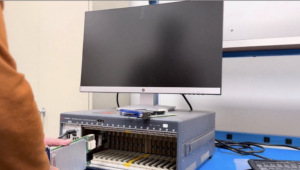Here’s How It Can be Observed and Studied
by Dr. Alan Whitney, MIT Haystack Observatory
How do you make a photograph of a black hole? Well, it isn’t easy. The nearest black hole to Earth (by far!) is at the center of the Milky Way galaxy approximately 25,000 light-years away. By carefully measuring the orbits of stars in the vicinity of the center of the Milky Way, we know that the mass of this black-hole monster, designated as Sagittarius A* (Sgr A*) is about 4 million times the mass of our Sun. Yet, according to calculations based on Einstein’s general theory of relativity, its diameter should be so small that it appears no larger to us on Earth than a golf ball on the moon! Even the largest optical telescopes in the world can’t begin to make an image of something that small.
Perhaps surprisingly, a global array of Earth-bound radio telescopes, all working together in a carefully choreographed dance, promises to make the first high-resolution images of Sgt A*. Led by MIT Haystack Observatory in Westford, MA and including collaborators from five continents, a project called the Event Horizon Telescope (EHT) is working to outfit and coordinate an array of radio-telescopes from Hawaii to Mexico to Chile to Europe to the South Pole using a technique called Very Long Baseline Interferometry (VLBI) that gathers data simultaneously from radio telescopes in all of these areas and combines all these data together to synthesize a single nearly Earth-sized radio telescope.
The anchor of the EHT is the new Atacama Large Millimeter Array (ALMA) situated on a 15,000 ft-high plateau in the Chilean Andes and jointly financed by the U.S., Europe and Japan. ALMA collects and combines data from almost fifty 12-meter-diameter high-precision antennas operating at a 1mm wavelength; this short wavelength is one of the few wavelengths that can cut through the dust and haze of the intergalactic media to even give us a shot at making a high-fidelity image of Sgr A*. But even them, the radio signals emanating from Sgr A*, believed to be mostly generated by the tremendous acceleration of charged-particle mass closely orbiting the black hole itself, is extremely weak. The most cost-effective way to improve the signal-to-noise ratio of observations of Sgr A* is the increase their bandwidth, which implies high data rates. Conventional VLBI recording rates typically max out at a few Gbps, but the observations of the EHT will in the next few years be pushed to 64 Gbps per telescope (ALMA counts as on telescope since its signals are combined locally before recording) and sustained for minutes at a time.
MIT Haystack Observatory and Conduant Corp. formed a collaborative partnership starting in 2001 to address the demands of high-data-rate recording for VLBI, resulting in the first VLBI disk-based systems (all previous recording had been to magnetic tape, topping out at about 0.5Gbps). The resulting series of Mark 5A/5B/5C system over the past decade have successively pushed the data rates from 1 to 2 to 4 Gbps with shippable multi-disk modules and affordable prices for the scientific community; some 150 Mark 5 systems are currently being used for VLBI around the world. The latest in these systems is the Mark 6 system, supporting sustained data rates to 16Gbps, and made even more affordable by incorporating commercial-off-the-shelf components. Initially, multiple Mark 6 units will be used at each telescope to reach the 64Gbps recording goal, but over the next few years we expect these capabilities to steadily rise at a fairly steady cost, largely driven by the inexorable force of Moore’s law.
VLBI data already collected from Sgr A* give us a glimpse of what is to come. There is palpable excitement in the air in the astronomy community as the EHT emerges from plans to reality and the images of Sgr A* become sharper and more detailed, revealing more and more details of this most mysterious of objects.
Stay tuned as MIT Haystack Observatory, with a little from Conduant, make history with new scientific insights regarding Sgr A*.



